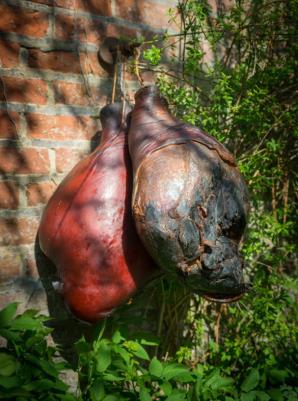

|
 Very dark sweet cured ham for cold eating. Pork legs soaked in salt and saltpetre brine, then pickled in a mixture of sugars with beer or cider for 3 or 4 weeks. Dried about one month, then cold smoked over oak.  Suffolk Ham from www.emmettsham.co.uk  Suffolk Ham from www.emmettsham.co.uk Wright's 'Standard cyclopedia of modern agriculture' of 1908 says that; "Suffolk hams, though very small, are cured till they are almost black" There has been some debate over the origin of Suffolk Ham. It isn't mentioned in the Board of Agriculture's very detailed survey of Suffolk in 1804. Eliza Acton in 1845 (below) says that the Suffolk cure is based on the one introduced to England by "the celebrated French cook, Monsieur Ude", whose 'The French Cook', with its 'Receipt to make a Ham better than those of Westphalia' was published in England in 1813.  Original Receipt from 'Modern cookery for private families' by Eliza Acton (Acton 1845) Original Receipt from 'Modern cookery for private families' by Eliza Acton (Acton 1845)Leg of Suffolk farm-house pork, 14 to 15 lbs.; saltpetre, 11/4 oz.; strong coarse salt, 6 oz.; coarse sugar, 8 oz. : 3 days. Fine white-wine vinegar, 1 pint. In pickle, turned daily, 1 month. Smoked over wood, 1 month. Obs. - When two hams are pickled together, a smaller proportion of the ingredients is required for each, than for one which is cured by itself.  Original Receipt in 'The French Cook' (1822) by Louis Eustache Ude Original Receipt in 'The French Cook' (1822) by Louis Eustache UdeReceipt to make a Ham better than those of Westphalia. As soon as the pig is cold enough to be cut up, take the two hams, and cut out the round bone, so as to have the ham not too thick; rub them well with common salt, and leave them in a large pan for three days; when the salt has drawn out all the blood, throw the brine away and proceed as follows: for two hams of about eighteen pounds each, take one pound of moist sugar, one pound of common salt, and two ounces of saltpetre, mix them together, and rub the hams well with it, then put them into a vessel large enough to contain them in the liquor, always keeping the salt over them ; after they have been in this state three days, throw over them a bottle of good vinegar. One month is requisite for the cure of them; during that period they must be often turned in the brine ; when you take them out, drain them well, powder them with some coarse flour, and hang them in a dry place. The same brine can serve again, observing that you must not put so much salt on the next hams that you pickle.  |
|
MORE FROM Foods of England... Cookbooks ● Diary ● Index ● Magic Menu ● Random ● Really English? ● Timeline ● Donate ● English Service ● Food Map of England ● Lost Foods ● Accompaniments ● Biscuits ● Breads ● Cakes and Scones ● Cheeses ● Classic Meals ● Curry Dishes ● Dairy ● Drinks ● Egg Dishes ● Fish ● Fruit ● Fruits & Vegetables ● Game & Offal ● Meat & Meat Dishes ● Pastries and Pies ● Pot Meals ● Poultry ● Preserves & Jams ● Puddings & Sweets ● Sauces and Spicery ● Sausages ● Scones ● Soups ● Sweets and Toffee ● About ... ● Bookshop ● Email: [email protected] COPYRIGHT and ALL RIGHTS RESERVED: © Glyn Hughes 2022 BUILT WITH WHIMBERRY |